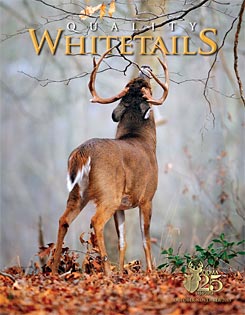Buck Movements and Mortality: Limitations in QDM Programs
By: Bronson Strickland and Dr. Stephen Demarais
Quality Deer Management (QDM) is an increasingly popular management strategy with today's landowners and hunters. QDM typically involves protection of young bucks coupled with an adequate harvest of antlerless deer to produce the desired herd size, age structure, and sex ratio. However, some landowners and hunters become frustrated with QDM after several seasons because they have not seen or harvested significantly older bucks than under previous management. In many cases, expectations exceed the ability of the management area to produce the desired number of older bucks. Additionally, many landowners and hunters do not understand how buck movements and mortality factors can limit the number of young bucks they are passing as yearlings from reaching the older age classes. In this article we will review how buck mortality, dispersal, and home range size may impact the success of your QDM program.
Mortality
The annual mortality rate for a deer herd is simply the percentage of the population that dies in a given year. Mortality can be attributed to hunting, poaching, predators, weather, disease, malnutrition, vehicle collisions, etc. Mortality rates vary by sex and age of deer and by season and region of the United States (Table 1). Understanding the most common sources of mortality in your area and the percentage of bucks lost to these sources will help you refine your management strategies.
Legal harvest is a significant source of mortality in most areas, and is controlled with regulations and hunter selectivity. Illegal harvest, on the other hand, is not easily controlled and has not been quantified, but is assumed to be substantial. In most of the Southeast, legal and illegal harvest account for most of the annual buck mortality.
Populations near the northern and southern boundaries of the whitetail's range have the highest reported non–hunting mortality. In these regions, up to 25 percent of all bucks may be killed annually by predators. Coyotes, wolves, and black bears have been reported predators of whitetails in the North, whereas, coyotes and mountain lions are the prominent predators in the Southwest.
The Southeast no longer has viable populations of large predators such as wolves and mountain lions that are capable of killing adult deer. Coyotes and bobcats are about the only significant predators of whitetails in the Southeast, and they mostly take fawns and adults that are sick or injured.
Most health–related mortality in the Southeast can be attributed to two causes—hemorrhagic disease and malnutrition–parasitism syndrome. Hemorrhagic disease (also known as bluetongue) viruses can kill up to 50 percent of a deer herd, although mortality rates are typically less than 15 percent. Deer populations in the South are confronted with these viruses much more frequently than their northern counterparts and have developed some immunity. Deer populations in northern latitudes may only encounter the disease every 5–10 years and suffer much higher mortality rates.
Malnutrition–parasitism syndrome is generally associated with high–density deer populations where the habitat has been chronically overbrowsed or where populations occur on very poor quality habitats. Nutritional stress makes deer much more vulnerable to both internal and external parasite infestations. Primary internal parasites include the large stomach worm and lungworm. Major external parasites include ticks and keds (deer lice). High deer densities can increase the transmission of these parasites to other deer. Actual mortality rates vary by parasite species and age and health of deer.
Legal and illegal hunting are usually the most important mortality factors in the Southeast. In comparison, legal hunting, weather, and predation are probably the most important in the North and Southwest. Table 1 details
numerous whitetail mortality studies throughout North America.
Dispersal
Dispersal is the process of an animal moving from its point of origin to where it reproduces. Most animals exhibit some form of dispersal to ensure exchange of individuals over time. Dispersal of bucks to and from your property can significantly impact the success of your management plan.
Reported dispersal rates vary from 40 percent in Virginia to 70 percent of bucks 8–18 months old in Maryland. Researchers in Maryland found that the number of yearling bucks dispersing onto their property was much lower than the number of yearling bucks dispersing from their property. This resulted in an annual net loss of yearling bucks. They suspected the reason for unequal dispersal was the intense harvest pressure from neighboring properties.
Legal harvest is typically the most significant factor limiting the success of QDM programs. Research in Mississippi demonstrated that the most significant cause of buck mortality was legal harvest. Clearly, control of legal harvest is required for a successful QDM program. Properties less than several thousand acres also must rely on cooperation from neighboring hunters.
Home Range Size
Home range is simply the area that an animal travels during its normal activities and is estimated during specific time periods (e.g., breeding or annual home range). Whitetail home range size varies by sex, age, and habitat type. Home range sizes of bucks throughout the United States are listed in Table 2. The average annual home range size for females is around 300–600 acres. The average annual home range for bucks is probably 2–4 times larger (600–2400 acres), and older bucks generally have larger home ranges than younger bucks.
Management Implications
We will use some hypothetical examples to illustrate how movement and mortality factors can affect the number of bucks on your property and, thus, the success of your QDM program. Suppose you are managing a 5,000–acre property with a deer density of 1 deer per 16 acres. If the adult buck to adult doe ratio is 1:2 and the annual fawn survival is 80 percent, you should have around 83 buck fawns alive at the beginning of the hunting season. Now we will evaluate the effects of natural mortality and harvest on these 83 buck fawns, and calculate how many would survive to maturity.
(Figure 1) Line 1 represents the effect that a 10 percent annual natural mortality rate would have on this group, with only 73 percent (61 of 83) surviving to 3.5 years old and 60 percent (50 of 83) surviving to 5.5 years old. Line 2 represents the effect of a 10 percent annual natural mortality rate and a 30 percent annual legal harvest. Only 25 percent (21 of 83) would survive to 3.5 years old and only 10 percent (8 of 83) would survive to 5.5 years of age with this combination. Line 3 represents the effect of a 10 percent annual natural mortality rate, a 30 percent annual legal harvest, and a 10 percent annual illegal harvest. Only 13 percent (10 of 83) would survive to 3.5 years while only 4 percent (3 of 83) survive to 5.5 with this scenario. Now imagine how these figures would change if you included unequal dispersal rates off and onto your property.

Now let us use the information on home range size to see how it could impact harvest levels on your property. If you have a 100–acre tract of land, no deer will be totally protected given the average home range size of over 600 acres. Let us look at another example, with a 5,000–acre tract (Figure 2). The box represents a property boundary and the circles represent the home ranges of deer. You can see that most of the deer could be vulnerable to harvest on surrounding properties. As the size of the management unit increases, the number of bucks that can be protected within the management unit also increases. Property
size and harvest intensity on peripheral properties can have a big impact on the success of your management plan.
Another source of frustration for hunters can come from differences in the susceptibility of bucks to harvest. The absence of older aged bucks in the harvest can lead hunters to believe that these animals are not present in the herd. Often older bucks do not expose themselves to hunters during daylight hours with about the only harvest opportunities occurring during the rut. Therefore, it is possible these older aged bucks are present but are not being harvested.
Conclusions
We hope the information provided in this article will assist you in understanding some of the factors that can affect the success of your QDM program. Local harvest rates, natural mortality rates, dispersal rates, and home range size all can play an important role in the success or failure of a plan. Landowners and hunters must have goals and expectations that are reasonable given these limitations. The degree to which a QDM program works is dependent on these and many other factors. Consultation with a biologist from your specific region about these considerations can help you fine–tune your management program and increase your chances of success.
Bronson Strickland is a Research Associate in wildlife biology at Mississippi State University. Dr. Stephen Demarais is an Associate Professor of Wildlife Management at Mississippi State University. This is Bronson's first contribution to Quality Whitetails.




























